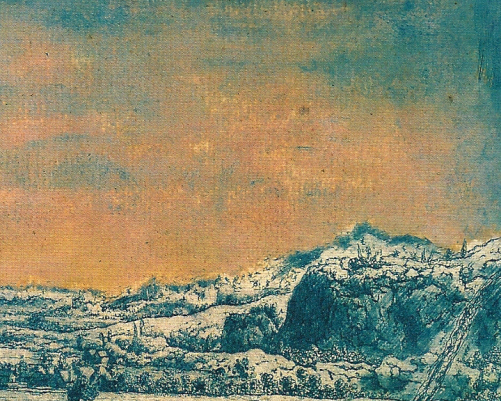
Hercules Seghers, early 1600s.
“Sixteen states saw their guard rolls double over the past decade {1990 to 2000} while most of them reduced overall public employment…state and county correctional adminstrations, taken together, have elevated themselves to the rank of third largest employer in the land, just behind Manpower Inc, and Wal Mart, and just ahead of General Motors…the U.S. carceral system now employs four times as many people as McDonalds and seven times more than IBM.”
Loic Waquant
Punishing the Poor
“It is no simple matter to determine the precise extent to which mass incarceration is exacerbating the deep socio-economic and related cultural and political traumas that already plague inner-city communities and help explain disproportionate Black “criminality,” arrest, and incarceration in the first place. Still, it is undeniable that the race to incarcerate is having a profoundly negative effect on Black communities. Equally undeniable is the fact that Black incarceration rates reflect deep racial bias in the criminal justice system and the broader society. Do the cheerleaders of “get tough” crime and sentencing policy really believe that African-Americans deserve to suffer so disproportionately at the hands of the criminal justice system? There is a vast literature showing that structural, institutional, and cultural racism and severe segregation by race and class are leading causes of inner-city crime. Another considerable body of literature shows that Blacks are victims of racial bias at every level of the criminal justice system‹from stop, frisk, and arrest to prosecution, sentencing, release, and execution.”
Paul Street
“[T]he British Empire acted as an agency for imposing free markets, the rule of law, investor protection and relatively incorrupt government on roughly a quarter of the world. The empire also did a good deal to encourage those things in countries which were outside its formal imperial domain but under its economic influence through the “imperialism of free trade.” Prima facie, therefore, there seems a plausible case that the empire enhanced global welfare–in other words, was a Good Thing.”
Niall Ferguson
I want to look at a piece Brad Evans wrote for L.A. Review of Books, about Jacques Ranciere’s recently translated book Figures of History. In which this piece by Alfredo Jarr is referenced.
http://alfredojaar.net/gutete/gutete.html
Here is a paragraph from Evans’ article (http://lareviewofbooks.org/review/facing-intolerable#) that starts with the famous Adorno quote on art after Auschwitz.
“…sometimes too easily drawn that the extermination is “unrepresentable” or “unshowable” — notions in which various heterogeneous arguments conveniently merge: the joint incapacity of real documents and fictional imitations to reflect the horror experienced; the ethical indecency of representing that horror; the modern dignity of art which is beyond representation and the indignity of art as an endeavor after Auschwitz.[iv]
Countering this problem of representing humanity’s negation, Rancière resurrects what is for many cultural theorists an all-too-familiar (if unresolved) debate:
So we have to revise Adorno’s famous phrase, according to which art is impossible after Auschwitz. The reverse is true: after Auschwitz, to show Auschwitz, art is the only thing possible, because art always entails the presence of an absence; because it is the very job of art to reveal something that is invisible, through the controlled power of words and images, connected or unconnected; because art alone thereby makes the human perceptible, felt.[v]
Rancière’s revision of the Adorno question should be taken seriously. Its purpose is to rethink the political function of art, and, in doing so, start the process that will allow us to reimagine a more artistic conception of the political that is not simply tied to perceptions of endangerment and the pure task of human survival.”

Larry Bell
There is a second passage I want to quote,
” He {Ranciere} focuses in particular on Jaar’s installation ‘The Eyes of Gutete Emerita’, which demands that the spectator first read about Emerita’s experience of the Rwandan genocide before being confronted with the woman’s concentrated and framed stare. Rancière acknowledges how the inversion of the gaze, the forced witnessing of the eyes upon the most horrendous acts, demands an appreciation of the way in which the intolerable can be turned into a recognition of humanity. As Rancière writes, instead of showing the mutilated bodies, Jaar’s work “restores the powers of attention itself.”[vii] The art historian and renowned cultural theorist Griselda Pollock notes the same, adding that Jaar’s installation asks the question “Will you too remember her eyes — eyes that look at you forever but forever see murder?”[viii] Jolting us “from the kind of consumption of the image that makes images out of atrocity without inducing a political response,” The Eyes register the experience that others had been obliged to witness. It is this element that marks the singularity of his work in creating encounters for the viewers far away from the event that force them to recognize a gap that has been cut into a living persons life by proximity to atrocity, by the wound that is trauma: an event too shocking to be assimilated.”
Evans says rightly that violence should be intolerable. Given that mass culture is now constantly finding various ways to depict violence and sadism for pleasure, this is pertinent and isnt too far from what I was trying to write about last time. However, the Jaar piece is highly problematic. In fact its far worse than problematic It is introducing the consumption of third world violence, as a subject, as a theme, even if making a rather portentious point about NOT showing the violence. The audience is asked to project their conceits onto the ‘eyes’ of the victim. A black African woman. But first, first the audience is admonished to read a bit of description. Except the description is the U.S. state department version of events. Griselda Pollock asks will you remember her eyes? This is white paternalism, and its additionally puerile and sophistic. Again, positing the savage, the one who saw ONLY murder.
Here is Dan Glazebrook on Robin Philpot correcting the party line. http://www.counterpunch.org/2014/03/21/the-real-lesson-of-the-rwandan-tragedy/
and Keith Harmon Snow’s interview here http://www.corbettreport.com/interview-886-keith-harmon-snow-reveals-the-truth-about-the-rwandan-genocide/
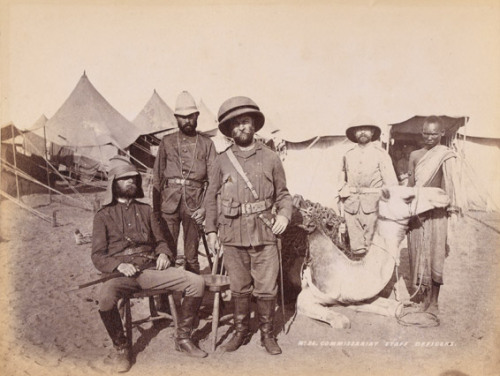
Royal Engineers, officers, Sudan 1885.
Additionally, this artwork of Jaar’s is frought with colonial cliches. It is a fetishizing of Africans as victims, and the use of eyes is reminiscent of much Colonial writing. The eyes of the predator, bloodshot, out of control; the prose of Empire while in the colonies is rife with descriptions of the eyes of the natives. This is almost caricature. These eyes are not like any others because they have seen a special horror. Secondly, there is something deeply sentimentalizing about this. The woman, the mother, helpless, but now (!) assisted by a white artist. A man! Artist as white savoir, who also gets to wring his hands, brimming with white guilt. Its very troubling frankly that Ranciere used this example, and that Evans didn’t take note.
D’Jeli Clark quotes Paul Landau’s book on photography and Colonialism:
“Toward the end of the 19th century, just as racial ideologues accomodated their thinking to Charles Darwin’s theory of evolution, photography fully took over the reportorial work of painters like [William Holman] Hunt and began to allow great numbers of urban people to “see” Africans living far away. The invention of the half-tone grid-system put photos in newspapers and books in 1888, and began the “10¢ magazine revolution.” Pictures froze images of “primitive” people who were supposed to be disappearing in the path of the very universalizing and homogenizing forces in which viewers were safely enmeshed. David Livingstone’s instructions to his brother, a photographer, transpose William Holman Hunt’s ideas into the incipient scientific language of the day: he asked Charles Livingstone to “secure characteristic specimens of the various tribes … for the purposes of ethnology.” Unlike “exhibitions,” traveling shows, and museums, photography illustrated Africa primarily by means of iconic signs, not indexical ones; like mobile displays, photography transferred “the location of analysis” back to the comfort of the metropole. Photography greatly increased people “in-the-know”: postcards, magazines, white hunter’s books, illustrated travel stories all yielded their messages in urban livingrooms and studies. The trajectory from painting to mechanical reproduction traced the shift from public display to private viewing.”
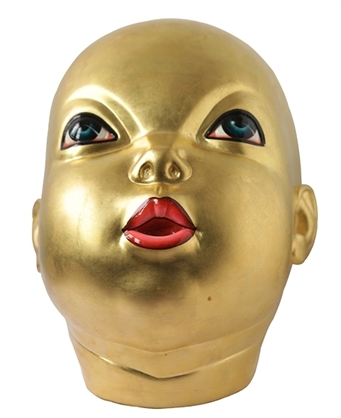
Chintan Upadyay
Clark adds that the Western imagination always saw the colonial subject in a rear view mirror. Framed by a colonial narrative and staging. The Jaar piece is not only politically misinformed, it patronizes the Rwandan people as victims that the white man failed to save. It is sending the Native back to the metropole, yet again. As to violence, the real violence, as Keith Harmon Snow says, goes back to include a history of slavery and plunder. But this piece exoticizes the conflict, the violence is ‘special’, it took place in the heart of darkness after all, and the white man ‘turned his back’ and allowed it happen (never mind the white man assisted in creating said violence). That is because, presumably, only the white man can problem solve.
Now as to the question of the social or political and its relationship to art, I will turn to Adorno, not least because his quote is part of Ranciere’s argument. Adorno though never addressed directly the social role of art. Rather he wrote of the tensions within individual works of art. For him the work of art represents the totality of society. Adorno wrote; “All that artworks do or bring forth has its latent model in social production.” The difficulty with Ranciere’s approach to art and society (and which Evans addresses quite well, which I will get to) is exactly related to Adorno’s aesthetics (and that quote). Lambert Zuidervaart says that for Adorno, art is ‘de-fetishizing fetishes’. This leads to a very complex but important discussion of the autonomy of art, and what Adorno called its ‘truth content’. Autonomy is socially mediated, but remains the precondition for truth content. Art is meant, for Adorno, to challenge the status quo. It also, as Evans notes, implies something unrealized, better, or Utopian in human aspiration. The problem with Adorno’s ideas on autonomy is that social institutions, mass culture, electronic media, have all changed the cultural and social landscape over the last fifty years. The post modern culture now rejects any idea of an absolute need for autonomy, or for heterogeneity. Even the idea of the Culture Industry needs revising. Still, the idea of art’s social purpose is always going to distort and over simplify the truth of art. When Gottfreid Holnwein is quoted:
“The world has been purged of fairies, elves, witches, angels, enchanted castles and hidden treasures. Dreaming and fantasizing is nowadays considered a chemical imbalance in the brain of the child. For reasons of national security there are no realms of imagination anymore in which to escape — children are held in the merciless headlight of the adults level-headed, common-sense-madhouse: a world of stock-markets, war, rape, pollution, television-moronism, prozak [sic], prison-camps, miss universe-competitions, genetic engineering, child pornography, Ronald McDonalds, Paris Hilton and torture.”
This is indeed the state of mass culture, and Evans says, correctly:
“Helnwein shows how facing the intolerable is not simply about revealing the raw reality of injustice in the present. It’s about transgressing the limits of mediated suffering. Or as Rancière might explain, it reveals precisely “the critical project of art” as it “eliminates its own lie in order to speak truthfully about the lie and the violence of the society that produces it.”
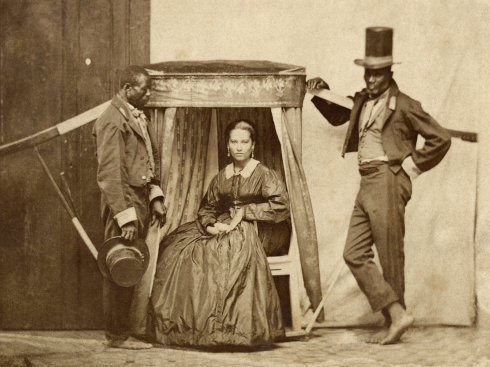
Bahia, Brazil. 1860 apprx. Photographer unknown.
The colonizing of consciousness by corporate interests and U.S. Imperialism though is highly complex, and the proof of that is in the problematic Jaar piece. And here one runs into the autonomy question. Institutional hegemony being what it is, the constant compulsive repetition of propaganda and jingoistic narratives and image are now feeding off themselves, and have created codes, or shorthand for imparting message and meaning. This is why the truth of the artwork is not found in its content but in its form, or rather that the form is the radicalizing precondition for the non-identical. On a slightly prosaic level, again, the form of the Jaar piece is deeply reactionary. It is related to an extraction of value from Africa. That value is embedded in how artworks are circulated, funded, and displayed. One cannot photograph Rwanda and then return that image to the former colonizer, the white advanced world, and not have been engaged in yet more exploitation. Even if the money is collected for charity, it is just further shaming. This is why the topic of violence cannot be a blanket term, and why complaints about exploding latex heads in zombie movies is the least of all problems. The violence of white superiority seen in the HBO show The Affair, a world of white problems made by a privileged friend of the Clintons, and produced by a major corporate purveyor of *entertainment*, is really a deeper form of psychic violence. The emphasis on the de sensitizing aspect of violence in entertainment is valid, but often couched in the most undialectical way, and often underscored with a certain Puritan distrust of art and culture. The violence theme becomes equated in this process with society’s licentiousness.
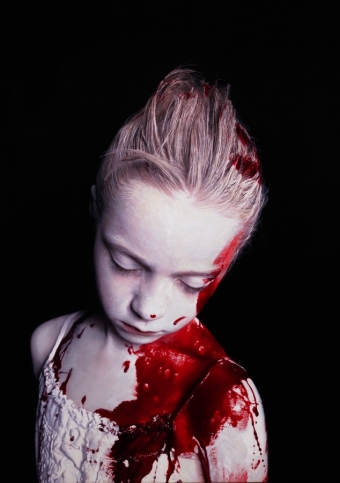
Gottfried Helnwein, “Disasters of War, 13”.
Now it is interesting that the Helnwein artwork under discussion is perhaps among his least effective. I think Helnwein is a very important artist. But the blood soaked little girl (blond in point of fact) is too literal an image, one too familiar, and one the opposite of provocative. We’ve seen very similar images in Vogue. I think this is an issue I write about a good deal, and it has to do with the spatializing of mimetic engagement, but also with the questions Evans asks here, which I think are perhaps not the right questions and are wrong in a very particular way. One does not read such an image by asking questions, anyway. The viewer is not conducting that sort of interrogation. Take a different Helnwein painting; the Donald Duck image on a street in downtown L.A. This image is far more disruptive. The lurking menace of that street, the lack of pedestrians, the color that saturates the photo on which this work is built..and the image of the Walt Disney character, Donald Duck, is more involved in raising questions. It is not overtly about violence, yet the uncertainty of that image, the anxiety, is in the end more durable, and destabilizing than Disasters of War 13. The duck character is suddenly unfriendly. He still smiles, but it is the smile of a torturer, or thief. Worse, a politician. My lifetimes assumptions are interrupted at that moment, my childhood memories, my trust in a personal nostalgia, are all invoked; the meaning of kitsch, of mass culture, is being put on trial. But by whom? For what? A hot summer night, as the title implies, a looming Liquor store, in a low rent industrial area (actually I know that street in L.A., in the loft district and its no longer so low rent) invoke filmic associations. This is a film noir image. This is Edgar G. Ulmer or Siodmak. The tragic turns into the grotesque said Jan Kott. Here the cartoon commodity turns into a threat, a unsettling and contradictory image suddenly seen on his way to buy a bottle of Night Train. It is neither grotesque nor is it not; the well known warmth of a Disney character becomes suspect, to be distrusted suddenly.
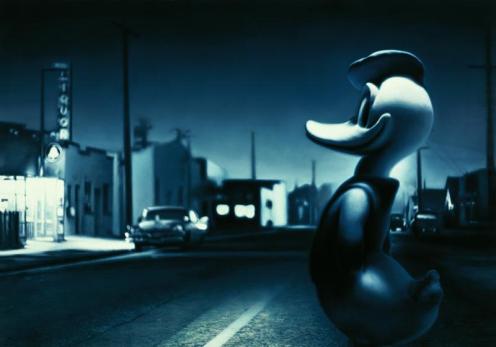
Gottfried Helnwein. “In the Heat of the Night”.
On the other hand, the bandaged little girl is teetering on the edge of bathos. It is close…not quite there….but close to maudlin. The idealized almost Victorian image of the girl, blond, dressed in white, with white make up, is an interesting image, and in the context of the entire ‘Disasters of War’ series, it is more effective. Helnwein serializes his works often, and it is usually from within those juxtapositions that the real effects of his image are found. As is, I think the dialectical movement within the piece is short circuited.
Evans summation is very good, and it cuts to the heart of I suspect everyone’s quibbles with Ranciere. I would argue that the central problem with discussions of art and politics is that art has no political purpose. It has political meaning. But its not meant to be propaganda. The social utility of art, its purpose lies exactly in its lack of purpose. There is where one finds its autonomy as well. And that is why, under the growing surveillance state, the more authoritarian mediation of daily life, such lack of purpose, or autonomy, is harder to find. The meaning, the PR, is *given* to the artwork before its made, almost. This is the real nightmare of the technological reproduction aspect of art; there is no fertile space left, psychically or literally for the making of art. Everything is commodified and reified, and everything made, even the most conceptual pieces, is appropriated instantly. And the possibility that appropriation takes place apriori might be the last frontier for the ‘brave new world’.

Sammy Baloji, photography. “Série Mémoire” (2006), Lubumbashi.
As to that Auschwitz quote. It may be that more people have written “that quote is misunderstood” than have actually misunderstood it. No other quote of Adorno’s comes close to the citings of this famous maxim. There is a better more relevant quote of Adorno’s.
“It is the lack of experience of the imagery of real art, partly substituted and parodied by the ready made stereotypes of the amusement industry, which is at least one of the formative elements of that cynicism that has finally transformed the Germans, Beethoven’s own people, into Hitler’s own people.” Adorno saw the collapse of education in Germany, and especially cultural and arts education, as a decisive element in the rise of National Socialism. As Hullot-Kentor points out, there were many Nazi SS officers who could play the violin, but that’s not the point. The hopes, Utopian dreams and desires of humanity, from religion to philosophy had morphed into aesthetic questions that seems threatened by the mass conflagration of World Wars 1 & 2. For Adorno, his last and ultimately unfinished book Aesthetic Theory is really about the possibility of art in the coming 21st century. The problem was that great art now had no audience. That cultural education had so collapsed that it was quite possibly too late for aesthetic concerns to rescue humankind. The cultured individual, civilized, humane, had disappeared.
Today, where once an idealized past was a foil for proving the destroyed present, there is the regrettable past (usually recent past) as proof our benevolent present. This is related to this discussion of a future pedagogy, which Evans raises quite rightly at the end of his article. Adorno, in his late work, had started to see style (and fashion, and novelty) as almost synonymous with domination. The constant production of the *new* is of course connected to mass production, but the cycle is now so accelerated that artworks (film especially perhaps) look dated almost as soon as they appear. Five years means a film looks old fashioned. This is because technical virtuosity has replaced form. Actual style is now just a new process, a new technical factor, a new version of the same. The new stimulates shopping. In other words, the genuinely *new* in art is that which ceases to imitate the marketing of consumer lines, the Spring line, the fall collection, the new and improved toothbrush. The relations of production don’t change much structurally, but the artwork must, as a first act, reveal the sameness under the mask of novelty. The aesthetic education will always be political. I don’t think one needs an aesthetics of the political. But I do think one needs a political reading of art, but not as message, but as history.
“Because artworks register and objectivate levels of experience that are fundamental to the relation to reality yet are almost always concealed by reification, aesthetic experience is socially as well as metaphysically compelling.”
Adorno

Santu Mofokeng, photography. Soweto, South Africa.
Today, mass culture, corporate culture, is enclosed within assumptions about entertainment, and it reflects the values of the corporate ownership class that makes it. It is repetitive, and yet predicated on ideas of novelty and originality. The role of popular culture today, though, has changed in another way. Where once popular forms of entertainment were simply a way to use up leisure time, or for distraction, today they are far more deeply intwined with morality, with behavioral attitudes (back to Adorno on style) and political opinion. But most of all they serve to instruct the individual, through the erasure of mimesis, and through repetition of its style codes, in psychological conformity. Never has a population so uniformly accepted propaganda. The last significant aspect of popular mass culture is the ways it silences radical voices. It disappears them. Either through hostile appropriation, through a hegemony of distribution, or through simple omission, which is really just the result of the first two.
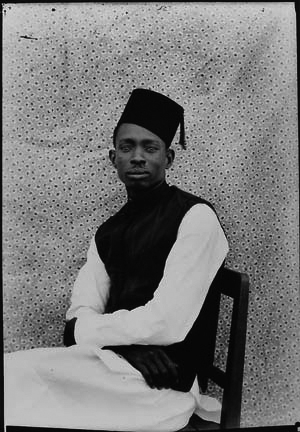
Keita Seydou, photography. Mali, 1950s.
A final note on African photography. I have mentioned this before, but in the light of the Jarr installation, its worth looking at Africa through African eyes. Keita Seydou was a photographer from Bamako, Mali. Born in 1921, he took a great many portraits in the 1940s and 50s in Mali. In a sense he was the African Disfarmer. Both men ran small streetfront shops and took pictures of everyday people, often on holiday, or for special occasions. Seydou took remarkably dry shots; austere almost. There is a quality of August Sander in his work as well. He is among my favorite photographers. But there are many others. Malik Sidibe, J.D. Aihumekeokhai Ojeikere, and Sammy Baloji, Depara, and Zanele Muholi, and South African Santu Mofokeng. There are great white African photographers as well, David Goldblatt and Pieter Hugo. The point is that Africans make their own art.

Obiora Udechukwu
I posted three images of work by Hercules Seghers, a printmaker and painter from the early 17th century. Rembrandt owned 8 paintings of Seghers, and only 12 overall survive today. Only 183 prints survive. Rembrandt modeled several of his own etchings on Seghers’ prints. Seghers is one of those geniuses who creates a small catalogue of a very specific vision of the world. Seghers work is, like a couple other artists from Holland in that era, surprisingly modern looking. There is a meticulous but never fussy discipline at work, and a boldness of compositional vision that one finds nowhere else in the early 1600s. In his own way Seghers reminds me of Pirinisi, the creator of worlds of infinite depth, from a vision that is unsually skewed from the norm of the period.
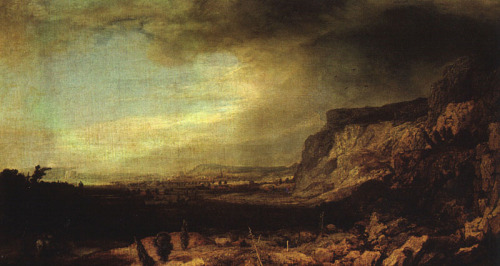
Hercules Seghers
Seghers prints are his greatest work, though his paintings are very fine. The prints resemble aquatint, but that was a later invention. These were sugar-lift prints (or sugar-bite, or lift ground technique) and this was a process rarely bothered with at the time because it was deemed hardly worth the effort. The effects achieved by way of the granulated sugar were not deemed significant at the time. Today the prints bear the strangeness of both Seghers vision and his technique. They have an odd sense of negative space, of illusion almost between foreground and background. But it is finally the framing, the sense of space, that unusual inexplicable Segherian space. Then there is the color. Segher’s prints are oddly elusive in their impressions on the eye; ochre and blue, and earth brown and damp greens. There is a nice summary of his work from the British Musuem here http://www.britishmuseum.org/pdf/HerculesSegers_painted-prints-introduction.pdf
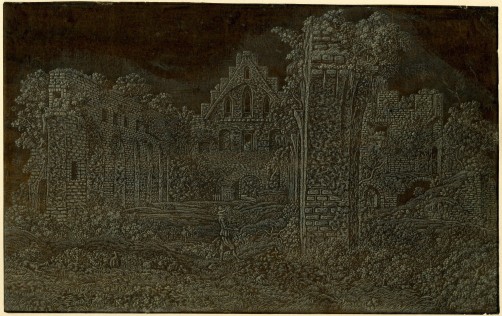
Hercules Seghers
There is another artist little known, really, who deserves mention. Adam Elsheimer, a 17th century German who is also connected to Rembrandt. Elsheimer was highly valued by Rembrandt’s tutor Peiter Lastman. Elsheimer is another of those remarkable minor figures who nonetheless exerted huge influence despite producing few works. Elsheimer died very young in his early thirties. A solitary depressive by all account, he, like Seghers, remains something of an enigma. There is actually not a great deal of biographical information on him, and of dubious reliability. He did certainly travel to Venice, and Rome. He may have studied there with an older German painter, Johann Rottenhammer. Elsheimer had two of Rottenhammer’s paintings among his belongings when he died. The older German specialized in cabinet paintings on copper. He knew the Flemish painter Brill, and both of them knew, in passing anyway, Rubens. Elsheimer converted to Catholicism, and married a Scottish/German woman while in Rome. After his death Rubens wrote; “one could have expected things from him that one has never seen before and never will see.”

Adam Elsheimer.
“Maiden Chased by Satyrs”.
He painted mostly on copper and on a small scale. His work is precise and strange, the subjects esoteric and the treatment is almost disorienting, really. He worked very slowly, and was in trouble often with his patrons.
Elsheimer and Seghers are both considered minor by virtue of their very small output. Neither were good businessmen and both led mostly solitary lives. Elsheimer did have an interest in science, and attended social gatherings at the Vatican botanical society for a time. It is interesting that both have a connection to Rembrandt, for it is Rembrandt more than any other painter of the 17th century who recuperated all that came before, synthesized it and produced something that completed what came before and initiated what came after. He invented the bourgeois individual as image much as Shakespeare did as mind. Western culture coalesced around the Dutch traders of the early 1700s, and the scale of ambition changed, the hubris of Capital, and the recognition of social hierarchy was part of the inner dialogue of people.
Adorno ends the section “Society” in Aesthetic Theory by asking a rhetorical question. “What would art be, as the writing of history, if it shook off the memory of accumulated suffering.” It is in the expression of art, that this suffering resides. It is the tension wrought by a denouncing of alienation and domination. But this is not found in becoming voyeurs to suffering. For that is is ideology, if we agree ideology is essentially false consciousness.

Adam Elsheimer.
“Saint Christopher Carrying Infant Christ”.

John Steppling:
Indeed, you have hit the nail on the head as regards the Jaar exhibit. There is so much unsaid, however, that is provoked by a knowing of the facts, which is absent in that exhibit. For example, Jaar was “horrified by images of corpses” he was seeing in the mass media during the so-called “100 Days of genocide” in Rwanda, and so what did he do? He went there: I wonder where he addresses his privilege. The man lives in New York, and jets around where he likes, and so in the summer of 1994 he jetted off to the bloodiest scenes he could find. How did he gain safe access to Rwanda in (blood-drenched) 1994? With rogue militias and “Hutu death squads” roaming about … oh, scuse me: It was August. The Rwandan Patriotic Front / Army (sic) had won the war. Wait, it wasn’t a war, but genocide, and the RPF/A — we are told and Jaar confirms — “stopped the genocide”. Nonetheless, how did he get into Rwanda at that time? Does one just fly into a death storm, show their passport and be welcomed with open arms by survivors? The only way to get into and out of Kigali (Rwanda) in 1994 was with the authorization and support of the RPF/A — the very killers that Jaar’s exhibit fails to name or recognize. Jaar’s problem is that “he is a traumatized man” — some art critic writes — and it’s no wonder: the effect of seeing all those dead bodies, for Jaar, must have been to cement in his mind and psyche the REALITY of what the propaganda system had already told him and, then, his handlers in Rwanda were sure to help him see. Handlers are the agents of the Kagame regime planted around the country to guide “tourists” and other voyeurs, like Jaar, to watch them (read: spy on and report about them) and to “handle” them to be sure they see only what they are meant to see. So, the entire exhibit, being about “seeing violence” differently, is extremely misguided, at best. Privilege, propaganda, psychic shock… Imagine creating an art exhibit out of 1,000,000 (1 million) images of this (supposed) Rwandan survivor’s eyes and mounting these 1 million images in frames and offering the art patron a loupe to view them (within a few centimeters, as the exhibit describes). That is privilege, heaped on falsehoods, re-presenting the interests of power, and capturing the imagination of art patrons (viewers) who see in the exhibit the horror, the horror. The Pentagon must be pleased. I wonder who funded the creation of 1 million images like that?
This is great.
It is kind of shocking to see Ranciere going for this, though it oughtnt be…he’s always worked to naturalize these narratives of the binaries europe and its other, enlightenment and its other, behind the ruse of dissent that consists of declaring allegiance to the [some euphemism for primitive]. Its extremely odd, for example, to read in Proletarian Nights, which is terrific archival work, his declaring gimnself amazed that laborers dislike their their drudgery and write poetry at night. Then he says “Marxists have taught us to expect labourerxs loving their drudgery”, And you know the guy has rarely strayed beyond the single digit arrondissements of Paris. The students of Althusser were such products of this sealed realm of perpetual schooling.
Still its astonishing such sensationalist, colonial horror formula shlock can be taken seriously by someone who has been pretty consistent on the rejection of this (he saw through Houllebecq if I recall righty). The endless barrage of colonial white supremacist mythnolgoy and topoi…from the politifcal propaganda to the reactionary cinema, I guess makes it possible for this shit, and it really is crap, its racism and its crappiness go together, to be passed off as serious.